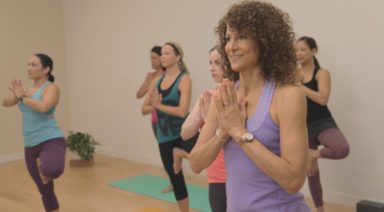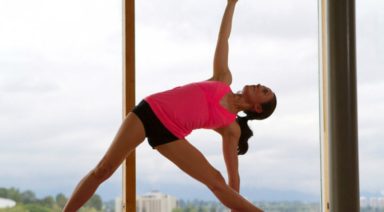Yoga: A Conversation with Your Body

When we do yoga we engage in a conversation with our body. I always encourage my students to observe, closely, what their bodies are telling them. Just in that moment, because change is constant. Do chair pose (utkatasana) hundreds of times and you’ll learn that your mind, body and emotions are always changing.
Standing in mountain pose (tadasana) encourages us to notice and to learn that we can stand alone, without support; that we can stand strong for what we believe in. Plow pose (halasana) puts us in a place where we can become introspective as we face our secrets– some delightful, some a little less so. What is our choice our response? In standing forward bend (uttanasana) or another pose like shoulderstand (salamba sarvangasana), we see the world from a different perspective. What is our interpretation?
I compare it to having a conversation with another person. We notice the body language. For example, someone taking a peek at their watch might want to be, or might have to be, somewhere else. They’re probably not fully present. Facing you directly with a relaxed stance means that they really are comfortable and interested in talking to you. These are all tiny little clues for understanding what might be going on in that person’s mind.
So is the case when it comes to the conversation we have with our bodies when we practice yoga. Perhaps, when scanning the body, you might find something a little rigid, or a little out of balance. What is the emotion behind that? What is your choice of response to that? Do you approach it with nonviolence (ahimsa)? Do you approach it with tenderness and respect? What if you found something that felt really good? Would you see it with truthfulness (asteya)? With non-possessiveness (aparigraha)? We need to learn to observe without judgement. Just like a witness.
Doing yoga, for me, is aparigraha. It’s about myself, and how I translate the world; understanding the choices I have and how I want to conduct myself. Learning is growing–the antithesis of stagnancy. You must learn about compassion for others, and learn to see others in yourself and yourself in others.
Use and share what you’ve learned as you go about your daily life.
3 Ways to Cultivate and Keep a Home Yoga Practice

Starting a home practice can be a daunting task. When I talk to students about starting a home practice, the same topics keep coming up: They don’t have the space or the time, they’ve tried but can’t stick with it or when they try, they don’t end up doing the type of practice they would like to. A home practice can teach you to follow your intuition and how to listen to your body. It will teach you to make time for yourself and it will allow you to reap the benefits daily practice can bring.
Below are my top three tips for starting and keeping, a home practice:
1. Keep a journal, calendar, or both.
Why? It keeps you accountable. By writing on your calendar that you are practicing that night, you’ll motivate yourself to practice so as to avoid staring at your missed commitment the following day. A missed practice can be a big kick in the pants.
I keep my journal on a shelf in my home practice space. When I was working on incorporating consistent practice into my life, having the journal there always got me to go to my practice area, even if I had told myself I didn’t have time, or was too tired to practice. No matter what, I could always convince myself that I had time to jot down what I was feeling in my journal. After a few instances of writing but not practicing, it started to feel ridiculous to be there and not practice. One new habit fed the other.
I have both a calendar and a health journal. I check my practice off on my calendar when I’ve completed it, and I write in the journal even if I don’t do a practice. Both keep me accountable and motivated.
2. Release your expectations. All of them.
Don’t worry about having the “perfect” space to practice. Don’t worry about how much time you were able to spend on your practice on any given day, and definitely don’t worry about the kind of practice you decide to do. Find a spot that’s big enough to roll out your mat and start there. If it helps, you can set up a special space where you can keep your yoga stuff. Try setting up an alter, but don’t let an imagined need for such a space keep you from starting your practice today. All you need is one space that is big enough to lay out a yoga mat. Period.
One of the issues I faced when I was starting my home practice was making the time. It seemed like a rare occasion when I had enough time to do what I would consider to be a practice; however, once I got serious about starting a home practice, this was one of the first beliefs that I had to let go off. Some nights I come to the mat exhausted and my practice is savasana, and only savasana. Whether you practice one pose or fifty, it doesn’t matter. I don’t judge and I don’t talk down to myself as though it wasn’t enough. I don’t wish I’d done “more.” I come to the mat with the time I have and I do what works for me on that day.
This goes for the type of practice too. When I started my home practice, I had this idea in my head that my mornings would be set aside for restorative and that I would rock a vinyasa flow in the evenings. I soon learned that I had to let go of what I thought I should be doing and just do what my body told me to do. If that meant doing restorative, I did restorative. If I felt energized, I did a flow. The same rules as above apply.
Don’t judge it, and don’t think it doesn’t count just because it didn’t meet an expectation you had set out for yourself. If you do, you’ll risk getting caught up in the downward spiral of feeling like you aren’t “really” doing a home practice, and once you’re there, it’s very easy to continue with those thoughts and eventually decide that your excuses and downfalls are more powerful than your wish to practice at home. This is where a lot of us end up. Don’t give up on yourself. Persevere through these thoughts.































